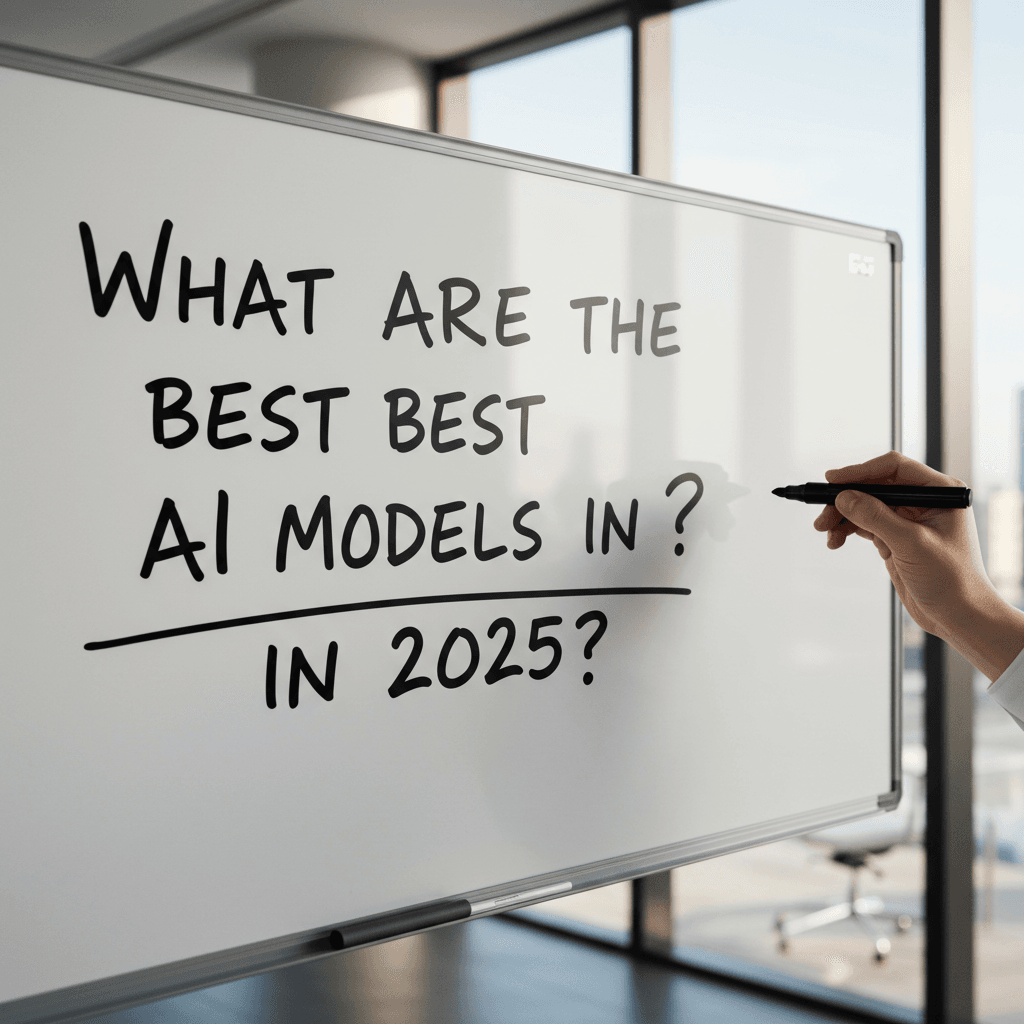What are the best AI Models in 2025?
As the AI landscape evolves, the leading models of 2025 demonstrate remarkable advancements in reasoning capabilities, multimodal processing, and specialized applications that transform how businesses and individuals interact with artificial intelligence. The current market shows a balance between powerful proprietary systems from tech giants and increasingly capable open-source alternatives that democratize access to cutting-edge AI technologies.
Key Takeaways
- GPT-4.5 maintains market dominance with 59.8% share in generative AI chatbots, offering superior natural language processing and reduced hallucinations
- Open-source models like DeepSeek R1 and Llama provide free, commercially viable alternatives for coding and academic applications
- Multimodal integration across text, voice, image and sensor data is becoming the industry standard in 2025
- Agentic AI systems that operate autonomously are projected to reach a $28B market by Q4 2025
- Ethical considerations remain significant as 42% of enterprises struggle with auditing proprietary models’ training data
The Proprietary Powerhouses: GPT-4.5 and Gemini 2.0 Pro
In 2025, GPT-4.5 continues to dominate the AI market with its impressive 59.8% share in the generative AI chatbot space. Its success stems from enhanced natural language processing capabilities and significantly reduced hallucinations compared to previous versions. The model operates in an “omni” mode that seamlessly integrates text, voice, and vision processing, making it exceptionally versatile for enterprise applications.
For businesses requiring commercial use, GPT-4.5 comes with a $200 monthly subscription through ChatGPT Pro. Organizations particularly favor it for customer service automation, though its proprietary nature does limit customization options. OpenAI has also introduced specialized variants like o3-mini (optimized for STEM tasks) and GPT-4o mini that deliver cost-efficient multimodal processing.
Google’s Gemini 2.0 Pro presents the strongest challenge to GPT-4.5’s market position with its 13.5% market share. The model boasts an impressive 128k-token context window and deep integration with Google Search and Workspace products. In benchmark testing, Gemini achieves 87.4% accuracy in MMLU-Pro assessments, which positions it between GPT-4.5 and DeepSeek in reasoning capabilities.
What sets Gemini apart is its “Flash Thinking Experimental” mode that reduces latency by 40% for real-time applications. However, the model hasn’t been without controversy, facing criticism for exaggerated demo videos and questionable benchmark comparisons according to industry analysts.
Emerging Contenders in the AI Arena
While GPT-4.5 and Gemini dominate headlines, several powerful contenders are reshaping the AI landscape in 2025. Alibaba’s Qwen 2.5-Max has emerged as a formidable competitor in benchmarks, outperforming many established models in Arena-Hard (84.3), LiveCodeBench (78.9), and GPQA-Diamond (73.4) tests. Pretrained on an enormous 20 trillion tokens, Qwen excels in code generation, automated forecasting, and low-latency customer support applications.
Elon Musk’s xAI has made significant strides with Grok 3, which leverages 10x more computational power than its predecessor. Its DeepSearch feature provides real-time synthesis of web and X (formerly Twitter) data, while its Think Mode enables complex reasoning for problem-solving. Early adopters report a 35% reduction in research time for market analysts using Grok 3.
Anthropic’s Claude 3.7 takes an ethics-first approach with constitutional AI principles designed to minimize harmful outputs. Its unique “Scratchpad” mode reveals the model’s reasoning steps, making it particularly valuable in fields requiring transparency like healthcare and legal services. While it matches GPT-4.5 in coding performance, it still lags in multilingual capabilities.
The Open-Source Revolution
Perhaps the most significant trend of 2025 is the rise of capable open-source AI models that democratize access to advanced capabilities. DeepSeek R1 leads this movement as a free, commercially usable model that specializes in coding and mathematical reasoning. It now powers 15% of GitHub’s AI-assisted coding tools, though users should be aware it’s subject to Chinese government censorship mandates.
Meta’s Llama continues to gain traction for its impressive efficiency, processing 12,000 tokens per second even on consumer-grade GPUs. This makes it ideal for academic research and low-cost NLP solutions. Universities report a 50% cost reduction using Llama compared to GPT-4.5 for prototyping AI-driven educational systems.
The open-source movement has also spawned region-specific models like Tencent’s Hunyuan Turbo S, which generates responses 2.3x faster than GPT-4.5 in Chinese-language tasks. This specialization gives it a significant advantage in Asian markets where it better understands regional dialects and cultural nuances.
Multimodal Integration: The New Standard
In 2025, the integration of multiple data types has become standard across leading AI models. This multimodal capability allows systems to process and synthesize information from text, voice, images, and sensor data simultaneously, creating more contextually aware and helpful AI.
Google’s Gemini demonstrates this powerfully in industrial settings, analyzing factory sensor data including vibrations and thermal images to predict equipment failures with 92% accuracy. In retail, IKEA has implemented multimodal AI that converts customer sketches into 3D product designs in under 10 seconds, revolutionizing the shopping experience.
This trend represents a significant leap from the history of AI improvements where models typically specialized in single data types. Now, the seamless integration of multiple sensory inputs creates AI systems that more closely mimic human perception and reasoning.
Agentic AI: Autonomous Systems Taking Control
Perhaps the most transformative development of 2025 is the rise of agentic AI—systems that collaborate with humans and other AI agents to accomplish complex tasks autonomously. This represents a fundamental shift from reactive to proactive AI capabilities.
Cisco provides a compelling example with its supply chain AI that negotiates with suppliers, forecasts demand, and reroutes shipments without human intervention. This level of autonomy allows businesses to operate more efficiently while freeing human workers to focus on strategic rather than operational tasks.
The market for agentic AI solutions is projected to reach $28 billion by Q4 2025, indicating strong business confidence in these systems. However, this growth raises important questions about oversight, responsibility, and the appropriate balance between human and AI decision-making.
Performance Benchmarks and Pricing
When evaluating AI models in 2025, understanding comparative performance is essential. The following benchmarks provide context for the current competitive landscape:
- GPT-4.5: 85.7% MMLU-Pro, 79.1% LiveCodeBench, trained on 13T tokens, $200/month
- Qwen 2.5-Max: 89.1% MMLU-Pro, 78.9% LiveCodeBench, trained on 20T tokens, $450/month
- Gemini 2.0 Pro: 87.4% MMLU-Pro, 76.3% LiveCodeBench, trained on 15T tokens, $300/month
- DeepSeek R1: 81.5% MMLU-Pro, 75.2% LiveCodeBench, trained on 8T tokens, Free
These metrics reveal that while proprietary models generally outperform open-source alternatives, the gap is narrowing. Organizations implementing AWS machine learning solutions often combine these models with cloud infrastructure to optimize performance and cost.
Ethical Considerations in AI Development
As AI capabilities advance in 2025, ethical considerations remain paramount. Anthropic’s Constitutional AI approach has demonstrated significant progress, reducing harmful outputs by 63% compared to GPT-4.5. However, transparency issues persist across the industry, with 42% of enterprises reporting difficulty auditing proprietary models’ training data.
This lack of transparency raises concerns about bias, fairness, and potential misuse. Organizations increasingly demand greater insight into how models are trained and what safeguards exist to prevent harmful outputs. The tension between proprietary technology and ethical governance represents one of the most significant challenges facing the AI industry in 2025.
For organizations implementing AI solutions, balancing cutting-edge capabilities with responsible use requires careful consideration of model selection, implementation frameworks, and ongoing monitoring. The most successful deployments pair technical excellence with robust ethical guidelines.
Sources
shakudo.io – Top 9 Large Language Models
e-discoveryteam.com – Breaking New Ground: Evaluating the Top AI Reasoning Models of 2025
itprotoday.com – AI Trends and Predictions 2025 from Industry Insiders
neontri.com – Google Gemini ChatGPT Comparison
yourstory.com – Top 10 AI Models 2025
upmarket.co – The Best AI Chatbots LLMs of Q1 2025
blog.google – AI Trends Business 2025
latest video
news via inbox
Nulla turp dis cursus. Integer liberos euismod pretium faucibua





